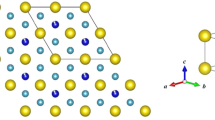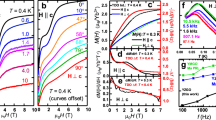Abstract
Neutron powder diffraction and inelastic neutron scattering data were used to simulate and understand the magnetization and heat capacity curves of the pseudobinary Tb x Pr1−x Al2, with x = 0.10 and 0.25, as a function of temperature. From the Rietveld analysis, we concluded that no crystallographic transition occurs in these samples, and the high symmetry of the magnetic structure was confirmed. Moreover, the different contributions from the reflection planes could be related to the known exchange bias-like effect characteristic for the x = 0.25 sample, also suggesting the existence of some rearrangement of the magnetic moments or even the presence of spin frustration in this system. Finally, the obtained set of theoretical parameters using the mean field approach for the two systems consisting of two sublattices allowed the experimental data to be described and to explain their physical behaviors. The ensemble of our results leads us to affirm that the quadrupolar interactions as well as an existence of some rearrangement of the magnetic moments or a frustration play an important role in the strong unidirectional anisotropy and the exchange bias-like effect observed in this pseudobinary system.






Similar content being viewed by others
References
Tishin AM, Spichkin YI (2014) Recent progress in magnetocaloric effect: mechanisms and potential applications. Int J Refrig 37:223–229. doi:10.1016/j.ijrefrig.2013.09.012
Tishin AM, Spichkin YI (2003) The magnetocaloric effect and its applications. IoP - Institute of Physics Publishing, UK
de Sousa VSR, Carvalho AMG, Plaza EJR et al (2011) Investigation on the magnetocaloric effect in (Gd, Pr)Al2 solid solutions. J Magn Magn Mater 323:794–798. doi:10.1016/j.jmmm.2010.10.046
Kulkarni PD, Thamizhavel A, Rakhecha VC et al (2009) Magnetic compensation phenomenon and the sign reversal in the exchange bias field in a single crystal of Nd0.75Ho0.25Al2. Europhys Lett 86:47003. doi:10.1209/0295-5075/86/47003
Kulkarni PD, Nigam AK, Ramakrishnan S, Grover AK (2010) Field induced changes across magnetic compensation in Pr(1−x)Gd(x)Al(2) alloys. http://arxiv.org/abs/1008.3782v1
Lacour D, Jaffres H, Dau FNV et al (2002) Field sensing using the magnetoresistance of IrMn exchange-biased tunnel junctions. J Appl Phys 91:4655–4658. doi:10.1063/1.1450050
Daughton J, Brown J, Chen E et al (1994) Magnetic field sensors using GMR multilayer. IEEE Trans Magn 30:4608–4610. doi:10.1109/20.334164
Lenz J, Edelstein S (2006) Magnetic sensors and their applications. IEEE Sens J 6:631–649. doi:10.1109/JSEN.2006.874493
Tsang C, Fontana RE, Lin T et al (1994) Design, fabrication and testing of spin-valve read heads for high density recording. IEEE Trans Magn 30:3801–3806. doi:10.1109/20.333909
Tsang C (1984) Magnetics of small magnetoresistive sensors (invited). J Appl Phys 55:2226–2231. doi:10.1063/1.333619
Ross RG Jr (2001) Cryocoolers. Kluwer Academic Publishers/Plenum Publishers, New York
Julio CGT, Heloisa NB, Sven L et al (2014) Efficient materials for cryogenic refrigeration: The interplay of the magnetocaloric effect and electrical resistivity in Tb(x)Pr( 1−x)Al2 ferrimagnetic compounds can help realize more efficient and advanced materials for cryogenic refrigeration. Magnetics Technology International Magazine, pp. 58–61
Jensen J, Mackintosh AR (1991) Rare earth magnetism: structures and excitations. Oxford University Press, Oxford
Purwins HG, Leson A (1990) Magnetic properties of (rare earth)Al2 intermetallic compounds. Adv Phys 39:309–403. doi:10.1080/00018739000101511
Tedesco JCG, Pires MJM, Carvalho AMG et al (2013) Exchange-bias-like effect in Pr0.75Tb0.25Al2 and Pr0.7Tb0.3Al2 samples. J Magn Magn Mater 339:6–10. doi:10.1016/j.jmmm.2013.02.049
Kulkarni PD, Venkatesh S, Thamizhavel A et al (2009) Exchange bias and its phase reversal in zero magnetization admixed rare-earth intermetallics. IEEE Trans Magn 45:2902–2906. doi:10.1109/TMAG.2009.2016417
Ovchinnikov Y, Dyugaev A, Fulde P, Kresin V (1997) Properties of a magnetic impurity in a metal. JETP Lett 66:195–201. doi:10.1134/1.567501
Ehrenreich H, Seitz F, Turnbull D (1969) Solid state physics: advances in research and applications. Academic Press, New York
Rodríguez-Carvajal J (1993) Recent advances in magnetic structure determination by neutron powder diffraction. Phys B Condens Matter 192:55–69. doi:10.1016/0921-4526(93)90108-I
Richard D, Ferrand M, Kearley GJ (1996) Analysis and visualisation of neutron-scattering data. J Neutron Res 4:33–39. doi:10.1080/10238169608200065
Olsen CE, Arnold G, Nereson N (1967) Magnetic properties of PrAl2. J Appl Phys 38:1395–1396. doi:10.1063/1.1709636
Nereson N, Olsen C, Arnold G (1968) Magnetic properties of PrAl2 and ErAl2. J Appl Phys 39:4605–4609. doi:10.1063/1.1655809
Oesterreicher H (1974) Constitution of aluminum base rare earth alloys RT2-RAl2 (R = Praseodymium, gadolinium, erbium; T = manganese, iron, cobalt, nickel, copper). Inorg Chem 13:2807–2811. doi:10.1021/ic50142a009
Lea KR, Leask MJM, Wolf WP (1962) The raising of angular momentum degeneracy of f-Electron terms by cubic crystal fields. J Phys Chem Solids 23:1381–1405. doi:10.1016/0022-3697(62)90192-0
de Oliveira NA, von Ranke PJ (2010) Theoretical aspects of the magnetocaloric effect. Phys Rep 489:89–159. doi:10.1016/j.physrep.2009.12.006
Kulkarni PD, Dhar SK, Provino A et al (2010) Self-magnetic compensation and shifted hysteresis loops in ferromagnetic samarium systems. Phys Rev B 82:144411. doi:10.1103/PhysRevB.82.144411
Bak P (1975) Magnetic excitations in rare earth Al2 compounds. AIP Conference Proceedings AIP Publishing, pp 152–158
Frauenheim T, Matz W, Feller G (1979) Crystal field effects in PrAl2. Solid State Commun 29:805–809. doi:10.1016/0038-1098(79)90166-2
Acknowledgements
JCGT greatly thanks Dimitri Argyriou (ESS, Sweden), Walter Kalceff (University of Technology, Australia), and Vinícius S. R. de Sousa (UERJ, Brazil) for providing fruitful discussions. The research of JCGT at the NBI was supported by the Brazilian Science Without Borders program (funds from CNPq), and further support was also provided by the Brazilian agencies FAPESP, Capes, and CNPq. The work performed at the large-scale facilities by JCGT, NCB and HNB was financed by Danscatt, while measurements performed on E9 (JCGT and HNB) and on TOFTOF (JCGT and NBC) were supported by the European Commission under the 7th Framework Programme through the ‘Research Infrastructures’ action of the ‘Capacities’ Programme, NMI3-II Grant number 283883. The authors gratefully acknowledge ISIS for the provision of beam time.
Author information
Authors and Affiliations
Corresponding author
Rights and permissions
About this article
Cite this article
Tedesco, J.C.G., Carvalho, A.M.G., Christensen, N.B. et al. Analysis of the crystallographic and magnetic structures of the Tb0.1Pr0.9Al2 and Tb0.25Pr0.75Al2 magnetocaloric compounds by means of neutron scattering. J Mater Sci 50, 2884–2892 (2015). https://doi.org/10.1007/s10853-015-8851-1
Received:
Accepted:
Published:
Issue Date:
DOI: https://doi.org/10.1007/s10853-015-8851-1




